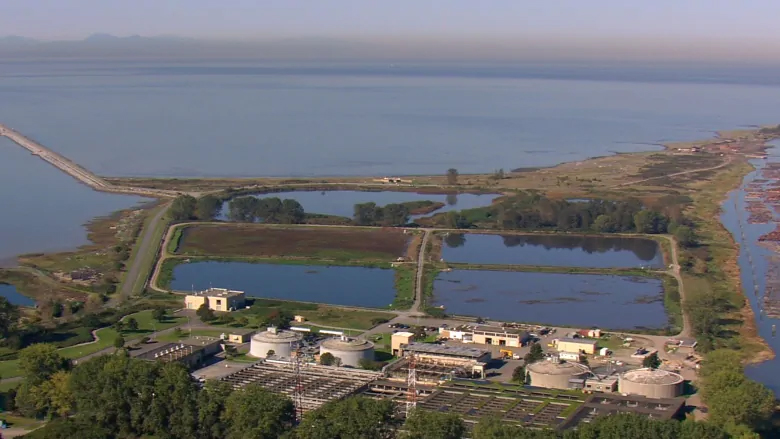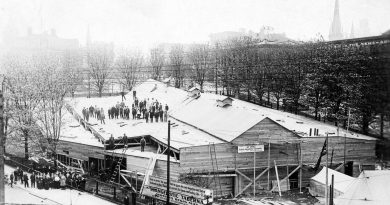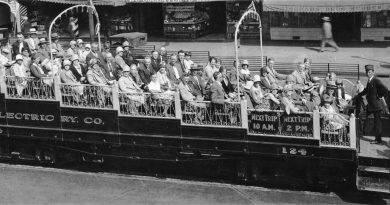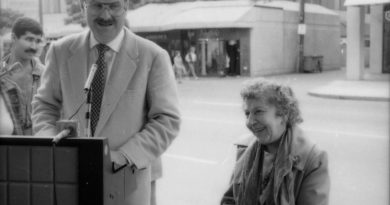1963
Above: The Iona Island Sewage Treatment Plant opened in Richmond in 1963.
[Image: Metro Vancouver]
*****************************************
You’ll note that these years include events listed under “Also in . . .” These are events for which we don’t have a specific date. If YOU know the specific date of an event shown there, please notify us . . . and cite the source! Many thanks!
*****************************************
January 2 The Ubyssey, the student newspaper at UBC, was named the best college newspaper in Canada. Editor Keith Bradbury accepted an award from the Canadian University Press organization. Later in 1963 Bradbury will publish an exposé on undercover RCMP agents spying on student political groups.
January 19 CJJC AM 850 Langley signed on as BC’s first full-time country music station. From this site.
April 2 Tolls came off the Lions Gate Bridge under its new owner, the provincial government, which had bought the bridge for $6 million. And a new wrinkle was added: overhead lane control signals enabled traffic in the centre lane of the three-lane bridge to be reversed according to traffic flow.
April 18 The Iona Island Sewage Treatment Plant opened in Richmond. At the time residents of Richmond were really unhappy with the decision to put it there: they wanted Vancouver to keep its own sewage. But, said the GVRD’s 1992 annual report, “the tides were against it — Iona was the best location to get a good tidal flushing action.” One of the major connectors to the plant is called the Highbury Tunnel, named for the west side street that runs above it. In some places the pipes are 300 feet beneath the surface.
April 19 There was real drama at the BC Penitentiary when rioting inmates, holding a hostage (prison guard Patrick Dennis), insisted on speaking in person to CKNW radio open-liner Jack Webster. The gutsy Webster met with them under extremely tense conditions and aired their grievances.
April 23 Prime Minister Lester B. Pearson took office.
May 27 Evergreen Studs Limited was incorporated. The company name would be changed to Primex in May, 1986. Its principal business is the manufacture and marketing of high value lumber products for the Japanese market.
May Former Vancouver police chief Walter Mulligan, forced out of his job in 1956 through scandal, returned to Canada from the USA. He and his wife Violet retired to Oak Bay.
June 8 The Agrodome, a domed exhibition hall, was opened at the PNE. The fair’s original proposal was for an 8,000-seat combined facility: a livestock arena that could be converted to an ice rink. Vancouver city council balked, and what was built was a 3,500-seat arena with a 230×100 foot ring, covered by a 50-foot-high domed roof. “Though they professed to be an agricultural fair,” say the authors of the 1982 book Vancouver’s Fair, “and stated repeatedly that the arena was needed primarily as an exhibition showcase, the PNE really wanted a home for their hockey team. They were being deliberately deceptive . . .” (Page 132.)
June Architect Arthur Erickson was inducted into the Royal Institute of British Architects, in effect a Hall of Fame. His most well-known local creations — Simon Fraser University, the Museum of Anthropology on the UBC campus, the law courts on Robson Street — are a small part of an international body of work that includes the Canadian Embassy in Washington, D.C., the San Diego Convention Center, Toronto’s Roy Thomson Hall, the University of Lethbridge and much more.
Summer The First Vancouver Sea Festival was held.
September 3 Maureen Chant (born in Goldfields, Saskatchewan May 8, 1939) began working for Jimmy Pattison at 18th and Cambie as the night switchboard operator of a two-car showroom dealership. “Jimmy was doing a fair bit of public speaking then,” she said in a 2002 interview, “and because of my proximity to his office I would listen to and critique his talks. The chemistry between us worked. I took courses and became his secretary — and then he got on the acquisition trail.” Today she handles Pattison’s personal finances, oversees operation of the company airplane, the yacht Nova Spirit, “Frank’s Place” in Rancho Mirage and arranges schedules for 100+ meetings a year, etc., etc., and etc.
September 6 Victor Odlum was named chairman of the Vancouver Times, a short-lived newspaper.
September 19 The Frederic Wood Theatre opened its doors with the English musical comedy Salad Days, staged in an old army hut along West Mall. Today the theatre contains three 50-seat classrooms and a 400-seat theatre. It was built at a cost of $600,000, half of which was paid for by the Canada Council. The theatre was named for one of UBC’s original faculty members, Frederic G.C. Wood, a Professor of English. UBC Theatre grads have played a major role in the Canadian theatre scene, especially in Vancouver. Their numbers include John Gray, Richard Ouzounian, Larry Lillo, Eric Petersen, Goldie Semple, Jeremy Long and Bill Millerd.
September 29 Jimmy (James) Cunningham, stonemason, died in Vancouver, aged about 85. He was born in 1878 on the Isle of Bute, Scotland. “He came from Scotland in 1910,” writes Constance Brissenden, “then served in WWI with the Canadian Expeditionary Force. He worked extensively as a stonemason, including at UBC, Vancouver homes, pools at Lumberman’s Arch, 2nd and Kitsilano beaches, Empress and Banff Springs hotels. In 1917 he began building the Stanley Park seawall. In 1931he was named master stonemason for Vancouver Parks Board to secure Stanley Park’s shores. He began at Brockton Point, supervising the building of the lighthouse and seawall around the point. Jimmy retired in 1955 but supervised the wall until his death, completing three miles. The remaining 1.5 miles in the Siwash Rock area were completed in 1980. A plaque was erected in his memory at Siwash Rock. His ashes are in an unmarked spot in the seawall.”
September The Killarney Community Centre opened.
October 2 The curtain went up on the first production by the newly formed Vancouver Playhouse Theatre Company: Brendan Behan’s The Hostage. Michael Johnston would be Managing Producer during the 1963/64 season, acting as producer, manager and designer. The Hostage was directed by Malcolm Black, who would go on to serve as Artistic Director of The Playhouse from 1964-67. For a history of the company, go here.
Built by the City of Vancouver to provide a facility for local arts groups The Playhouse also became home to the Friends of Chamber Music, the Festival Concert Society and the Vancouver Recital Society.
October 24 The Hebb Building officially opened at the University of British Columbia, named in memory of Thomas Carlyle Hebb, a Professor of Physics at UBC from 1916-1938. Hebb was built as a teaching addition to the Physics Department. At a cost of $1.4 million, the building houses tutorial rooms, laboratories and the second largest lecture theatre on campus, seating 450 students.
October 26 Donald Cameron Brown, businessman, died in Vancouver, aged 71. He was born February 22, 1892 in Winchester, Ontario. He came to Vancouver in 1910. Brown served as a pilot with the Royal Flying Corps in the First World War. He married Buda Hosmer on September 9, 1919. Brown was founder and president of Wild Rose Mills from 1933 to 1962. He was elected twice as a Coalition MLA (Vancouver-Burrard, 1945 and 1949), was defeated in 1952. He and his wife joined Social Credit in 1954. He was prominent in local organizations such as The Vancouver Board of Trade and Kiwanis, and was a director of TUTS (Theatre Under the Stars).
October 30 William Moore, photographer, died in Burnaby, aged 75. He was born December 11, 1887 in Bryson, Quebec. Moore came to Vancouver in 1912 from Banff, and set up a studio in his home on East 21st Avenue. He later moved to Sophia Street. He was one of two panoramic photographers in the city, specializing in photos 8 inches high and up to 8 feet wide. He took hundreds of views from 1913 to 1953, including English Bay, sporting events and cityscapes. From 1920 to 1946 he photographed the annual New Westminster May Day celebrations. His camera was a Kodak No. 8 Cirkut. He donated 370 Cirkut images to the Vancouver City Archives.
October It was all-star time at Vancouver Opera as their production of Bellini’s Norma had a young Joan Sutherland and Marilyn Horne singing together with Sutherland’s husband, conductor Richard Bonynge, in the pit.
November 21 Marathon Realty was incorporated.
November 22 US President John F. Kennedy was shot dead in Dallas by Lee Harvey Oswald.
November 24 Nightclub owner Jack Ruby shot Lee Harvey Oswald dead in Dallas.
November 26 A memorial service for President Kennedy was held at UBC.
November 30 Alexander Campbell Des Brisay, chief justice of BC, died in Vancouver, aged about 75. He was born in 1888 in Winnipeg. Des Brisay was elected president of the Vancouver Bar Association in 1941, was treasurer of the BC Law Society from 1953 to 1955, and became chief justice of the BC Court of Appeal in 1958. He was the head of a one-man royal commission on workmen’s compensation in 1962. When he died, he had produced 6,000 pages of transcripts for the as-yet unfinished enquiry. His wife, Ella Helen, died the following morning (Dec. 1, 1963 in Vancouver) of a heart attack.
November The Vancouver Tourist Association moved to new premises at 650 Burrard and got a new name: the Greater Vancouver Visitors and Convention Bureau.
Also in 1963
Bill Rathie became mayor of Vancouver, the first actually born in the city (April 1, 1914). He will serve to 1966. “The last in a long line of NPA mayors,” wrote Donna Jean McKinnon, “Rathie’s terms of office coincided with a new emphasis in civic politics on the issues of the urban environment and its livability. As a tax expert and accountant, these were perhaps not the kinds of issues closest to his heart, but his contributions were noteworthy. A 20-year program for Vancouver’s redevelopment, encompassing transportation, low-cost housing, and downtown revitalization was under consideration and led to, among other things, a new Georgia Viaduct giving easier access to the downtown. Low-cost housing projects including MacLean Park and Skeena Terrace were developed. Rathie got into hot water over the amount paid for renovations to the mayor’s office at City Hall, something he defended as necessary and fitting to the city’s highest office.”
Sherwood Lett, chief justice of BC, ruled that expropriation of a private company, B.C. Electric, by the provincial government’s B.C. Hydro and Power Authority, was illegal. The province was forced to pay far more to acquire B.C. Electric.
Prescott, Ontario-born (June 5, 1901) Bruce Hutchison, who had started his lifelong career in journalism as a sports reporter for the Victoria Times in 1918, became editor of The Vancouver Sun.
Donald Cromie, son of Robert Cromie, the founder of The Vancouver Sun, sold the paper to the Sifton family’s FP Publications, leaving Vancouver with no locally owned newspaper.
Marianne Linnell, chair of the BC Aviation Council, banned backyard burning in Vancouver.
Seattle-born Warren Tallman, teacher and literary critic, who had arrived in Vancouver in 1956 to teach at UBC, began to organize major poetry conferences in Vancouver and the US. The Tallman home was a centre of modern poetry in the city and introduced a generation of young writers to modernism.
New Westminster-born (July 18, 1891) radiologist Ethlyn Trapp was awarded a citation from the Canadian Medical Association for cancer research. She was the director of the B.C. Cancer Institute from 1939 to 1944, the first woman to be president of the B.C. Medical Association (1946-47); first woman president of the National Cancer Institute of Canada (1952) and president of the Federation of Canadian Medical Women.
Earle Birney, 54, who had been teaching literature at UBC since 1946, started Canada’s first creative writing department.
Theatre Under The Stars in its original form (it was founded 1940) closed, but would be revived as a semi-professional company in 1969. Stanley Park’s Malkin Bowl, where TUTS presented its shows, closed for six years.
The UBC Physics Building, opened in 1948 by Premier John Hart, was dedicated in honor of Dr. A.E. Hennings, a UBC Professor of Physics for 29 years.
East and west residence wings were added to the Anglican Theological College on the UBC campus.
Patricia E. Roy presented her 276-page MA thesis at the University of Toronto: Railways, politicians and the development of the city of Vancouver as a metropolitan centre 1886-1929. In 1980 Ms. Roy will give us her solidly researched book Vancouver: An Illustrated History.
The Canadian Yearbook of International Law/Annuaire Canadien de Droit International first appeared. This annual originates with the University of British Columbia Press, contains articles on international law, Canadian practice in international law, and a digest of Canadian cases in public international law.
Outlook first appeared. Published 10 times a year by the Canadian Jewish Outlook Society, it provided a Jewish secular humanist perspective on political and cultural issues.
BC Hydro’s Burrard Thermal generating plant at Port Moody was completed. Some years much of Greater Vancouver’s electricity (and about 12 per cent of total provincial supply) comes from Burrard Thermal. (You can see its six tall stacks emitting steam just west of the Ioco refinery on the north shore of Burrard Inlet). Wrote Jim Lyon in The Greater Vancouver Book: “Originally the plant was designed to burn either crude oil or natural gas but a decision was made in 1978 to switch to natural gas only. High pressure steam is passed through turbines to generate electricity — almost 7,000 gigawatt-hours of electricity a year, enough for 700,000 homes, if needed.” Construction cost $150 million.
Hugh Forrester, who in 1925 bought Purdy’s Chocolates from founder Richard Purdy (who started the firm in 1907), sold it in turn to Charles Flavelle. Under Flavelle’s stewardship, Purdy’s grew from four stores to a chain of 45, located throughout BC, Alberta and Washington. It is now the largest manufacturing retailer of chocolate in BC, and the second largest in Canada.
The BC Lions got into the Grey Cup, but lost to Hamilton Tiger Cats 21-10.
The Hollyburn Country Club was opened in West Vancouver.
Sculptor George Norris created striking internal and external decoration for Holy Name Church, at 4925 Cambie.
The Chessmen began, featuring singer Terry Jacks.
The Vancouver Playhouse company was formed.
Canada’s first national modern dance festival was held in Toronto. The lone BC participant was Vancouver’s Norbert Vesak, born in Port Moody in 1936 and called by Max Wyman “Vancouver’s first modern dance professional.” See this site.
The movie The Bitter Ash, directed by Lawrence Kent, was made with a University of B.C. student cast and crew. Movie reviewer Michael Walsh wrote that Larry Kent’s directorial debut drama “upset censors across Canada with its despairing portrait of a would-be playwright (Alan Scarfe) lost in a world of sex and drugs.”
The 366-seat Metro Theatre Centre opened at 1370 SW Marine Drive. The Metropolitan Co-op Theatre Society has been one of Vancouver’s most prominent community theatre companies ever since, producing an average of 10 shows per season.
Australian-born (October 10, 1924) author James Clavell, whose novel King Rat was a 1962 success, moved to West Vancouver.
Author Eileen Kernaghan, who was born in Grindrod, BC in 1939 and grew up on a farm, moved to Burnaby. See this site.
Meteorological writer Timothy Oke, born in Devon, came to Canada this year and would begin teaching at UBC in 1970. He was until 1996 head of the geography department. Oke is co-editor with Graeme Wynn of Vancouver and its Region, an overview by 19 UBC geographers. He is the author of The Climate of Vancouver. Oke is a Fellow of the Royal Society of Canada and the Royal Canadian Geographic Society.
Lawyer Angelo Branca, who had been practising in Vancouver since 1926, became a judge on the BC Supreme Court.
After ten years on the job, Frederick Soward stepped down as head of UBC’s history department.
Troll’s restaurant moved into a new building in Horseshoe Bay.
Pollution coming down the Nicomekl and Serpentine Rivers put an end to oyster farming at Crescent Beach, which had flourished for decades.
Stalo natives Mary Peters and Adeline Lorenzetto began to revive the ancient art of Salish weaving. Their work began to receive international recognition.
Construction began on Simon Fraser University. Dr. Harold Kalman has written: “SFU was one of many new universities founded across Canada as the baby boomers reached college age. The concept of Arthur Erickson and Geoffrey Massey, with the former as principal designer, was chosen by competition. The linear scheme, sited along the ridge of Burnaby Mountain, organizes the university by use, rather than by faculty or college. The broad Central Mall, designed by Erickson/Massey, is the principal walkway and meeting-place. It is covered by a glazed roof, supported by deep girders made of Douglas fir beams and steel tie-rods. To either side are the exterior walls of integrated campus buildings, including the W.A.C. Bennett Library (Robert F. Harrison). To the east, up a broad staircase, is the Academic Quadrangle (Zoltan S. Kiss). The planning forces student interaction, and was blamed for student unrest in the late 1960s — a tribute to the power of architecture to influence our actions.”
“In 1963 the architectural firm Christiani and Nielsen,” wrote Taras Grescoe in an article on Unbuilt Vancouver, a listing of grand schemes that never came to fruition, “unveiled an image of Coal Harbour with a new island off Stanley Park, part of a $58 million third crossing scheme. Cars were meant to follow a highway along Vancouver’s waterfront, veer off onto a four-lane bridge that plunged into Burrard Inlet at a tunnel entrance set into ‘reclaimed land’ off Brockton Point, and re-emerge at the other end of the tunnel on the North Shore.”
Dr. A.R. Lord died. Alexander Russell Lord was a prominent educator, BC inspector of schools and principal of the Provincial Normal School. An elementary school in Vancouver is named for him. On their web site the school has this: “Nova Scotia born, Dr. Lord came to British Columbia before the First World War and was principal of Kelowna Elementary until 1916, when he was appointed an inspector of schools. His inspections included Prince Rupert (then a very large district covering most of northern British Columbia), the Okanagan and Vancouver. He became principal of Vancouver Normal School in 1936, retiring from this position in 1950. From the same period he was a member of the University of British Columbia Senate. He was President of the Canadian Educational Association in 1948-1949.”
Kevin Falcon, BC’s minister of transportation, was born in North Vancouver.
A major sewage plant was installed on Iona Island, attached to Richmond’s Sea Island by a causeway. The plant provides primary treatment to wastewater from approximately 600,000 people (in Vancouver, the University Endowment Lands and parts of Burnaby and Richmond) before discharging it through a 7.5 km, deep-sea outfall into the Strait of Georgia.




